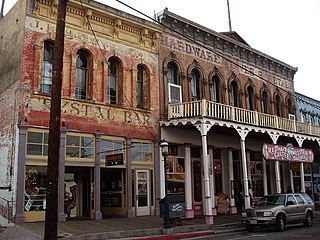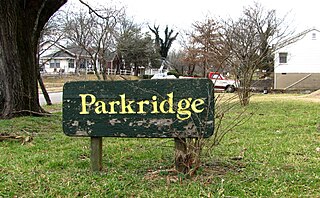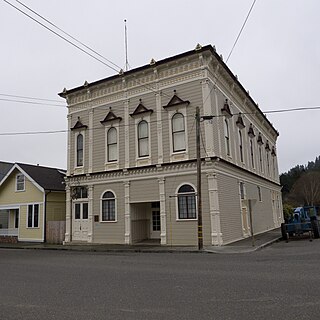
The City of Ranson is a city in Jefferson County, West Virginia, United States. The population was 4,440 at the 2010 census. Although the Census Bureau listed it as a town in 2000, it is classified as a city by state law.

Richardsonian Romanesque is a style of Romanesque Revival architecture named after Architect Henry Hobson Richardson (1838–1886). The revival style incorporates 11th and 12th century southern French, Spanish, and Italian Romanesque characteristics. Richardson first used elements of the style in his Richardson Olmsted Complex in Buffalo, New York, designed in 1870. Multiple architects followed in this style in the late 1800s; Richardsonian Romanesque later influenced modern styles of architecture as well.

Foggy Bottom is one of the oldest late 18th- and 19th-century neighborhoods in Washington, D.C., located west of the White House and downtown Washington, in the Northwest quadrant. It is bounded roughly by 17th Street NW to the east, Rock Creek Parkway to the west, Constitution Avenue NW to the south, and Pennsylvania Avenue NW to the north.

Rossland is in the West Kootenay region of south central British Columbia. High in the Monashee Mountains, the city lies immediately east of the intersections of BC highways 3B and 22. The facilities provide a winter base for the nearby multi-peak ski hills of the Red Mountain Resort.

Peabody & Stearns was a premier architectural firm in the Eastern United States in the late 19th century and early 20th century. Based in Boston, Massachusetts, the firm consisted of Robert Swain Peabody (1845–1917) and John Goddard Stearns Jr. (1843–1917). The firm worked on in a variety of designs but is closely associated with shingle style.

The Hull–Rust–Mahoning Open Pit Iron Mine in Hibbing, Minnesota, United States, is the largest operating open-pit iron mine in Minnesota. The pit stretches more than three miles (5 km) long, two miles (3 km) wide, and 535 feet (163 m) deep. It was established in 1895 and was one of the world's first mechanized open-pit mines.

Virginia City Historic District is a National Historic Landmark District encompassing the former mining villages of Virginia City and Gold Hill, both in Storey County, as well as Dayton and Silver City, both to the south in adjacent Lyon County, Nevada, United States. Declared a National Historic Landmark in 1961, the district is one of only six in the state of Nevada.

The T.G. Richards and Company Store, also known as Whatcom County Courthouse and James B. Steadman Post No. 24, is the first and oldest brick building in the state of Washington, United States, and is listed on the U.S. National Register of Historic Places.

Blakeley, near Charles Town, West Virginia is also known as the Washington - Chew - Funkhouser House, and was built in 1820 by John Augustine Washington II, great-nephew of George Washington and grandson of John Augustine Washington. It is a contemporary of its neighbor, Claymont Court, built across Bullskin Run by John's brother, Bushrod Corbin Washington. John Washington did not attempt to match the grandeur of Claymont Court, as he was in line to inherit Mount Vernon, and did so in 1829.

Roger Preston Chew was a noted horse artillery commander in the Confederate Army of Northern Virginia during the American Civil War. After the war, he was a prominent West Virginia businessman and railroad executive, as well as a West Virginia legislator.

Portland University was a private, Methodist post-secondary school in Portland, Oregon, United States. Founded in 1891 in a split from Willamette University, the school closed in 1900. The campus was located in what is now the University Park neighborhood and later became home of the University of Portland. The original campus building, West Hall, still stands and is listed on the National Register of Historic Places.

Red Dog was a California gold rush mining town located in the Gold Country in south-central Nevada County, California, United States, 6 mi (9.7 km) northeast of Chicago Park. Red Dog Hill, a mine and campsite, was founded by three men all under the age of 22, and was named by their youngest, a 15-year-old prospector. As mining operations grew, the campsite became a settlement, and then a town with a population of 2,000 residents, before it was eventually abandoned. Still considered important today, Red Dog Townsite is listed on the National Register of Historic Places. Red Dog has been noted for its unusual place name.

The Abell-Kilbourne House in Martinsburg, West Virginia is associated with John N. Abell, a prominent Martinsburg businessman and Charles W. Kilbourn, a Martinsburg mill owner. The former president of the Old National Bank, Abell developed the area known as "Abell's Addition" after his retirement in 1886. At that time Abell lived at 506 West Burke Street.

Parkridge is a neighborhood in Knoxville, Tennessee, United States, located off Magnolia Avenue east of the city's downtown area. Developed as a streetcar suburb for Knoxville's professional class in the 1890s, the neighborhood was incorporated as the separate city of Park City in 1907, and annexed by Knoxville in 1917. In the early 1900s, the neighborhood provided housing for workers at the nearby Standard Knitting Mills factory.

The Masonic Temple in Ferndale, California is located at 212 Francis Street, in an Eastlake-Stick style building built in 1891. The Masonic Hall is a contributing property in the Ferndale Main Street Historic District which was added on 10 January 1994 to the National Register of Historic Places. Ferndale Masonic Lodge F & A. M. #193 holds meetings in the building.

Swalwell Cottage is a historic house located at 2712 Pine Street in Everett, Washington.

John James Huddart (1856–1930), known usually as John J. Huddart, was a British born and trained architect who practised out of Denver, Colorado in the United States. At the end of the Nineteenth century he was one of Denver's leading architects, known for his work on public buildings and as a courthouse architect. His practice lasted from 1882 to 1930 and commissions included Charles Boettcher House in Denver, Colorado's Fort Morgan State Armory, Denver's Filbeck Building, and six of Colorado's county courthouses.

The Alabaster Historic District is a 400-acre mining complex in Iosco County, Michigan, centered on an open pit gypsum mine. It is bounded by on the east by Lake Huron, on the north by Gypsum Road, on the south by Keystone Road, and on the west by Rempert Road, south of Tawas City, the county seat. This historic district, where mining started in 1862, was listed on the National Register of Historic Places in 1977. Gypsum produced here was used to manufacture the temporary buildings of the World's Columbian Exposition in Chicago in 1893. The Alabaster Mining Company is still operating here.

The Henry Lockwood House is a historic house located in Harpers Ferry, West Virginia. Built in 1848, the building was originally constructed to serve as the Paymaster’s Quarters of the U.S. Federal Arsenal at Harper's Ferry. The house was significantly renovated in 1858 shortly before the American Civil War and again in 1883 while a part of Storer College.






















